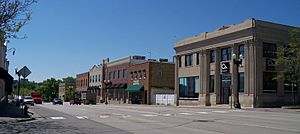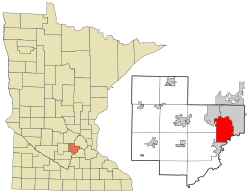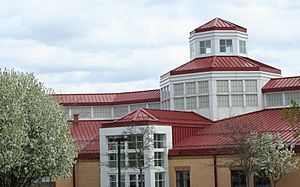Chaska, Minnesota facts for kids
Quick facts for kids
Chaska
|
|
|---|---|

Buildings in downtown Chaska
|
|
| Motto(s):
"A Quality Small Town"
|
|

Location in Carver County, Minnesota
|
|
| Country | United States |
| State | Minnesota |
| County | Carver |
| Area | |
| • Total | 17.85 sq mi (46.24 km2) |
| • Land | 17.02 sq mi (44.09 km2) |
| • Water | 0.83 sq mi (2.15 km2) |
| Elevation | 732 ft (226 m) |
| Population
(2010)
|
|
| • Total | 23,770 |
| • Estimate
(2021)
|
27,467 |
| • Density | 1,585.26/sq mi (612.08/km2) |
| Time zone | UTC-6 (CST) |
| • Summer (DST) | UTC-5 (CDT) |
| ZIP code |
55318
|
| Area code(s) | 952 Exchanges: 361,368,448,556 |
| FIPS code | 27-10972 |
| GNIS feature ID | 0641129 |
Chaska is a city in Carver County, Minnesota, United States and the county seat. An outer ring suburb of the Twin Cities, Chaska is home to the Hazeltine National Golf Club and is known for its historic downtown area located on a bend of the Minnesota River. The City of Chaska merged with Chaska Township in 2006. The city still has some remaining agricultural land.
The population was 23,770 at the 2010 census.
Contents
History
Chaska's history reflects the influence of the Native American culture. The first inhabitants are believed to be the Mound Builders, whose ancient communities are marked by mounds in City Square. Later, the Dakota (commonly known as the Sioux) were the primary nation in this region known as the Big Woods. Although the Indian mounds located in Chaska City Square indicate the immediate area was inhabited years before 1769, that's the year Chaska's recorded history began.
In 1776, Jonathan Carver explored the lands along the Minnesota River and chronicled his journeys. French Canadian fur traders traveled the waterways, trading with the Dakota in the early 19th century. During this time, Jean-Baptiste Faribault established a trading post in Chaska.
In 1851, the Treaty of Traverse des Sioux officially opened Little Rapids, as Chaska was then known, to settlement. Soon after, speculators moved into the new territory. Among the earliest was Thomas Andrew Holmes who, in August 1851, claimed a 20-acre (81,000 m2) clearing as the Chaska townsite.
The name "Chaska" is derived from a Dakota word often given as a name to the first born male child. Records show that David L. Fuller purchased the "Shaska" townsite from Holmes in 1852. In 1857, the townsite was platted by the Shaska Company. In the same year, construction began on the original Carver County Courthouse located where the post office and KleinBank now stand in downtown Chaska. Chaska was incorporated as a village in 1871 and, by special legislative charter, as a city in 1891.
An abundance of high quality clay led to the start of brick making in 1857. By the 1880s, as a result of the clay resources, Chaska was a thriving brick manufacturing center. Bricks were shipped by boat to Saint Paul and, although the city grew as a result of steamboat trade, it was not until the Minneapolis and St. Louis Railway was built through town in 1873 that rapid expansion began.
With the advent of the 20th century came other industries, including the processing of beet sugar and other agricultural products; flour making, butter making, the canning of peas, corn, and tomatoes, and the curing of sauerkraut and pickles.
National polls named Chaska the eighth-best city in the United States in 2007 and 20th best in 2009.
In September, 2016, Chaska hosted the Ryder Cup at Hazeltine National Golf Course.
Geography
According to the United States Census Bureau, the city has a total area of 17.77 square miles (46.02 km2), of which, 16.97 square miles (43.95 km2) is land and 0.80 square miles (2.07 km2) is water. The downtown portion of Chaska lies on the Minnesota River.
Chaska Boulevard (Old Highway 212), Pioneer Trail, U.S. Highway 212, and Minnesota State Highway 41 are four of the main routes in Chaska.
| Climate data for Chaska, Minnesota | |||||||||||||
|---|---|---|---|---|---|---|---|---|---|---|---|---|---|
| Month | Jan | Feb | Mar | Apr | May | Jun | Jul | Aug | Sep | Oct | Nov | Dec | Year |
| Average high °F (°C) | 22 (−6) |
28 (−2) |
40 (4) |
57 (14) |
69 (21) |
78 (26) |
81 (27) |
78 (26) |
71 (22) |
58 (14) |
41 (5) |
26 (−3) |
54 (12) |
| Average low °F (°C) | 4 (−16) |
9 (−13) |
21 (−6) |
34 (1) |
46 (8) |
56 (13) |
60 (16) |
58 (14) |
49 (9) |
36 (2) |
23 (−5) |
8 (−13) |
34 (1) |
| Average precipitation inches (mm) | .73 (19) |
.66 (17) |
1.73 (44) |
2.53 (64) |
3.69 (94) |
4.64 (118) |
3.49 (89) |
5.05 (128) |
3.41 (87) |
2.47 (63) |
1.64 (42) |
.95 (24) |
30.99 (789) |
| Source: The Weather Channel | |||||||||||||
Demographics
| Historical population | |||
|---|---|---|---|
| Census | Pop. | %± | |
| 1880 | 1,068 | — | |
| 1890 | 2,210 | 106.9% | |
| 1900 | 2,165 | −2.0% | |
| 1910 | 2,050 | −5.3% | |
| 1920 | 1,966 | −4.1% | |
| 1930 | 1,901 | −3.3% | |
| 1940 | 1,927 | 1.4% | |
| 1950 | 2,008 | 4.2% | |
| 1960 | 2,501 | 24.6% | |
| 1970 | 4,352 | 74.0% | |
| 1980 | 8,346 | 91.8% | |
| 1990 | 11,339 | 35.9% | |
| 2000 | 17,449 | 53.9% | |
| 2010 | 23,770 | 36.2% | |
| 2020 | 27,810 | 17.0% | |
| U.S. Decennial Census 2018 Estimate |
|||
Throughout the first half of the 20th century, Chaska's population averaged about 2,000 and the nature of the city remained unchanged. The city retained its small-town image until the 1950s when the transition to a metropolitan community began. The expansion of the seven-county metropolitan area reached Chaska in the 1960s. With that expansion came the introduction of the Jonathan New Town design concept in 1966. The Jonathan "new town" development within Chaska brought new land, new jobs and new people to the community.
This period of transition and expansion continues today. Dozens of modern industries have located to Chaska and continue to do so; residential construction adds 300 to 400 new homes per year; commercial business continues to expand offering a variety of retail and service opportunities to its residents; redevelopment of commercial areas in the downtown began in the 1980s and still continues. Although the community has seen much growth, development regulations and sound planning have ensured Chaska's small sense of community and the preservation of its rich heritage.
In early 2005, the city of Chaska annexed the remaining portion of Chaska Township. Current plans for the area include a 600-acre (2.4 km2) residential "smart growth"-styled development.
A new spike in the population occurred after the construction of the Highway 212 freeway passing through the heart of Chaska, serving as a fast, direct, link to the heart of the Twin Cities. This freeway includes a bus rapid transit route serving Chaska with fast, efficient mass transit, along with convenient access to the Light Rail system which connects the southwest suburbs to the Twin Cities of Minneapolis and St Paul.
As of 2000, the median income for a household in the city was $60,325, and the median income for a family was $69,612. Males had a median income of $45,401 versus $32,312 for females. The per capita income for the city was $25,368. About 3.4% of families and 4.7% of the population were below the poverty line, including 5.9% of those under age 18 and 6.4% of those age 65 or over.
2010 census
As of the census of 2010, there were 23,770 people, 8,816 households, and 6,188 families residing in the city. The population density was 1,400.7 inhabitants per square mile (540.8/km2). There were 9,290 housing units at an average density of 547.4 per square mile (211.4/km2). The racial makeup of the city was 88.1% White, 2.5% African American, 0.4% Native American, 3.7% Asian, 3.4% from other races, and 2.0% from two or more races. Hispanic or Latino of any race were 8.5% of the population.
There were 8,816 households, of which 41.9% had children under the age of 18 living with them, 54.6% were married couples living together, 11.1% had a female householder with no husband present, 4.5% had a male householder with no wife present, and 29.8% were non-families. 23.9% of all households were made up of individuals, and 6% had someone living alone who was 65 years of age or older. The average household size was 2.68 and the average family size was 3.22.
The median age in the city was 33.8 years. 30% of residents were under the age of 18; 6.9% were between the ages of 18 and 24; 30.8% were from 25 to 44; 25.7% were from 45 to 64; and 6.6% were 65 years of age or older. The gender makeup of the city was 49.8% male and 50.2% female.
Popular culture
Johnny Cash refers to Chaska in his popular song "I've Been Everywhere" as a place he has visited.
Cheryl Strayed briefly lived in Chaska during her early life, and mentions so in her popular book Wild: From Lost to Found on the Pacific Crest Trail.
Chaska is also home of the "World's Largest" 3D printed "Mustache". Found at 516 N Pine St. in downtown Chaska, the mustache is nearly 12 feed wide, and took over 300 hours to print.
Economy
Starting in 2004, the city government offered low-cost, high-speed wireless internet service for residents, businesses, and government entities throughout the community through a service called Chaska.net, but the program was canceled, after more than 10 years, in 2015 due to a decreasing customer base and large costs to upgrade equipment. Chaska is the home of numerous industrial and manufacturing concerns. Among them are TPI Specialties, Update Ltd, Wigen Water Technologies, Beckman Coulter and Hartman Homes.
Over the years, Chaska has also been the birthplace of several well known products and companies, including Softsoap, NordicTrack, and Heartland America. One such company, My Pillow, has received significant media coverage for multiple lawsuits as well as controversial issues focusing on its founder, Mike Lindell.
Opening in December 2015, the Chaska Curling Center has exceeded expectations as becoming a landmark in the city. The Center has helped with not only expanding Chaska community engagement and positively impacting downtown businesses, but also bringing the city national and international recognition as well as tourism. In 2016, to commemorate the start of the international Ryder Cup tournament, hosted in Chaska, the Norwegian and American Olympic teams squared off for an International Bonspiel, again bringing international eyes to the community. In 2018, the Chaska Curling Center was named a USA Curling National Training Center for the United States Curling Association, which means the Curling Center is able to host national events with USA Curling, and the USA Curling High Performance Program and Development Program can use the Chaska Curling Center for practices, camps, and events.
Top employers
According to the city's 2019 Comprehensive Annual Financial Report (CAFR), the top employers in the city are:
| # | Employer | # of Employees |
|---|---|---|
| 1 | Entegris Inc | 1,000 |
| 2 | Beckman-Coulter, Inc | 925 |
| 3 | ISD #112/Eastern Carver County | 880 |
| 4 | TEL-FSI, Inc | 850 |
| 5 | Carver County | 700 |
| 6 | The Bernard Group | 646 |
| 7 | Lake Region Manufacturing Co., Inc | 600 |
| 8 | Old National Bank | 560 |
| 9 | City of Chaska | 509 |
| 10 | Apex International, MFG | 400 |
Education
Children attend the Eastern Carver County School District (public). The school district used to be called District 112, but the name was changed when the district expanded. Elementary schools located in Chaska include Clover Ridge Elementary, Jonathan Elementary, and La Academia Spanish Immersion. The District 112 middle schools, all of which are in Chaska, are Chaska Middle School East, Chaska Middle School West, and Pioneer Ridge Middle School. Chaska High School and Chanhassen High School are the district's two high schools. Southwest Christian High School, which is a private high school, is also in Chaska. Several private grade schools are also in town, including St. John's Lutheran Church and School, and Guardian Angels Catholic School.
Notable people
- Phillip Bartlett, actor, voice of Mewtwo in the first Pokémon movie.
- Greg Boe, Representative, District 47-B, Minnesota House of Representatives
- Tony Denman, actor
- Ryan Dungey, Professional motocross rider for team Red Bull/KTM
- Brad Hand, MLB pitcher for the Cleveland Indians
- Kris Humphries, NBA power forward for the Phoenix Suns
- Jeff Isaacson, a two-time American Olympic curler
- Jerry Koosman, MLB pitcher, two-time All-Star for the New York Mets
- Mike Lindell, conservative businessman and founder of My Pillow
- Gordon Paschka, former NFL player
- Erik Paulsen, United States Congressman, MN 3rd Congressional District
- Mike Reilly, defenseman for the Boston Bruins
- Howie Schultz, MLB first baseman for the Brooklyn Dodgers, NBA power forward for the Minneapolis Lakers
- Edward Van Sloan, actor
See also
 In Spanish: Chaska (Minnesota) para niños
In Spanish: Chaska (Minnesota) para niños



